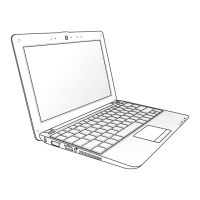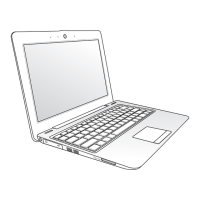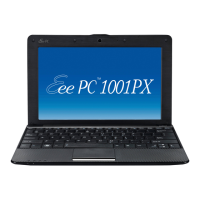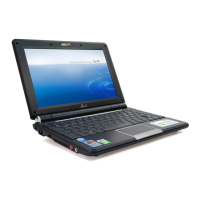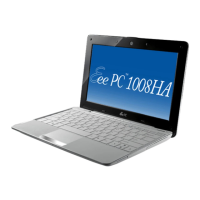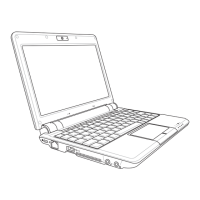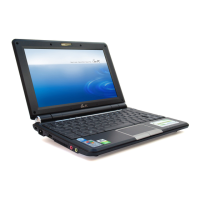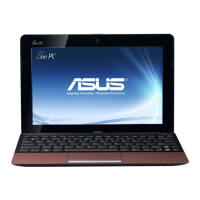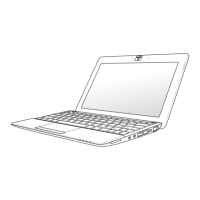Do you have a question about the Asus Eee PC 1005HA and is the answer not in the manual?
Provides information on the Eee PC's components.
Provides information on getting started with the Eee PC.
Provides information on using the Eee PC's utilities.
Gives information on support DVD contents and system recovery.
Gives you safety statements and other supplementary information.
Various warnings about placement, environment, liquids, heat, and battery handling.
Guidelines for safely transporting, temperature limits, and proper disposal of the Eee PC.
Instructions on how to properly charge the Eee PC battery for optimal life.
Guidance on using the Eee PC on airplanes and airport security checks.
Introduces the components located on the top side of the Eee PC.
Introduces the components located on the bottom side of the Eee PC.
Introduces the components located on the front side of the Eee PC.
Introduces the components located on the right side of the Eee PC.
Introduces the components located on the left side of the Eee PC.
Covers the usage and functions of the Eee PC keyboard.
Covers the usage and gestures for the Eee PC touchpad.
Details the built-in microphone, camera, and display panel.
Describes the power switch, keyboard, and touchpad/buttons.
Overview of various status indicators on the Eee PC.
Explains the LED indicators for battery status.
Describes indicators for HDD activity and wireless/Bluetooth status.
Indicates the status of the Caps Lock key.
Describes the spring-loaded battery lock mechanism.
Details the battery pack and the manual battery lock for securing it.
Information about the dedicated compartment for the memory module.
Description of the built-in stereo speaker system.
Details the memory card reader and audio output/microphone jacks.
Information on Universal Serial Bus and Ethernet LAN ports.
Covers the DC power input and VGA display output ports.
Details the USB port and the Kensington security lock port.
Explains the function of the air vents for cooling.
Covers F1 (Suspend), F2 (Wireless), F3 (Touchpad), F4 (Resolution).
Covers F5/F6 (Brightness), F7 (Backlight), F8 (External Display).
Covers F9 (Task Manager), F10 (Mute), F11/F12 (Volume).
Covers Insert, Delete, PgUp/Dn, Home/End, Windows Icon, Menu Icon.
Explains multi-finger gestures like zooming on the touchpad.
Provides quick instructions for powering on the Eee PC.
Guide for initial Windows setup and configuration.
Introduces the desktop shortcuts and applications.
Overview of the utility for power and display adjustments.
Instructions for establishing network connections.
Step-by-step guide to install battery, connect adapter, and turn on the Eee PC.
Steps for welcome, system settings, time zone, and license agreement.
Configuring updates and setting computer name/description.
Explains desktop shortcuts and application icons.
Details on managing devices and adjusting display resolution.
Guide to connecting to a wireless network using the notification area icon.
Instructions for establishing a wired network connection.
Steps to configure network settings using a dynamic IP address.
Steps to configure network settings using a static IP address.
Instructions for using Internet Explorer and visiting ASUS websites.
Additional tips for browsing, including specific ASUS URLs.
Frequently asked questions and solutions for wireless LAN setup.
Utility for managing and updating the Eee PC BIOS.
Guide to connecting and configuring Bluetooth devices.
Features for managing power modes and performance.
Suite of tools and applications for enhanced Eee PC experience.
Instructions to start a free trial of Microsoft Office.
Steps to update the Eee PC BIOS using an internet connection.
Steps to update the Eee PC BIOS using a downloaded BIOS file.
Guide through the initial configuration of Bluetooth.
Description of available power modes and their impact on performance.
Features for online entertainment and games.
Offers software applications and multimedia content online.
Includes Data Sync, EzMessenger, and Eee Storage for file management.
Covers display improvements (Splendid) and audio enhancements (SRS).
Provides access to Live Update, Parental Control, Font Resizer, and Easy Mode.
Steps to activate and start the free trial of Microsoft Office.
Overview of the contents of the Eee PC support DVD.
Information on restoring the Eee PC to its original state.
Feature to shorten Eee PC bootup time.
Instructions for inserting and launching the support DVD.
Explains the Drivers, Utilities, and Contact menus.
Steps to restore the system using the support DVD.
Steps to restore the system using the built-in recovery partition.
Instructions to disable the Boot Booster feature in BIOS.
Contains various regulatory and safety declarations.
Legal notice about manual reproduction and ASUS's warranty disclaimer.
Legal disclaimer regarding ASUS's responsibility.
Information on obtaining technical support and service from ASUS.
FCC compliance and interference guidelines.
Cautionary statement on radio frequency exposure.
Statements of conformity with R&TTE directive and CE mark warning.
IC compliance and RF exposure guidelines for Canada.
Specific SAR values for different wireless standards.
Details wireless channel usage for different regions and France restrictions.
Safety precautions for telecommunications equipment and modem usage.
Guidelines for approved power cords based on electrical ratings.
Information on compliance with REACH chemical regulations.
Warnings regarding lithium-ion battery replacement and disposal in multiple languages.
Legal notice about manual reproduction and ASUS's warranty disclaimer.
Legal disclaimer concerning ASUS's liability for damages.
Information on obtaining technical support and service from ASUS.
Provides information on the Eee PC's components.
Provides information on getting started with the Eee PC.
Provides information on using the Eee PC's utilities.
Gives information on support DVD contents and system recovery.
Gives you safety statements and other supplementary information.
Various warnings about placement, environment, liquids, heat, and battery handling.
Guidelines for safely transporting, temperature limits, and proper disposal of the Eee PC.
Instructions on how to properly charge the Eee PC battery for optimal life.
Guidance on using the Eee PC on airplanes and airport security checks.
Introduces the components located on the top side of the Eee PC.
Introduces the components located on the bottom side of the Eee PC.
Introduces the components located on the front side of the Eee PC.
Introduces the components located on the right side of the Eee PC.
Introduces the components located on the left side of the Eee PC.
Covers the usage and functions of the Eee PC keyboard.
Covers the usage and gestures for the Eee PC touchpad.
Details the built-in microphone, camera, and display panel.
Describes the power switch, keyboard, and touchpad/buttons.
Overview of various status indicators on the Eee PC.
Explains the LED indicators for battery status.
Describes indicators for HDD activity and wireless/Bluetooth status.
Indicates the status of the Caps Lock key.
Describes the spring-loaded battery lock mechanism.
Details the battery pack and the manual battery lock for securing it.
Information about the dedicated compartment for the memory module.
Description of the built-in stereo speaker system.
Details the memory card reader and audio output/microphone jacks.
Information on Universal Serial Bus and Ethernet LAN ports.
Covers the DC power input and VGA display output ports.
Details the USB port and the Kensington security lock port.
Explains the function of the air vents for cooling.
Covers F1 (Suspend), F2 (Wireless), F3 (Touchpad), F4 (Resolution).
Covers F5/F6 (Brightness), F7 (Backlight), F8 (External Display).
Covers F9 (Task Manager), F10 (Mute), F11/F12 (Volume).
Covers Insert, Delete, PgUp/Dn, Home/End, Windows Icon, Menu Icon.
Explains multi-finger gestures like zooming on the touchpad.
Provides quick instructions for powering on the Eee PC.
Guide for initial Windows setup and configuration.
Introduces the desktop shortcuts and applications.
Overview of the utility for power and display adjustments.
Instructions for establishing network connections.
Step-by-step guide to install battery, connect adapter, and turn on the Eee PC.
Steps for welcome, system settings, time zone, and license agreement.
Configuring updates and setting computer name/description.
Explains desktop shortcuts and application icons.
Details on managing devices and adjusting display resolution.
Guide to connecting to a wireless network using the notification area icon.
Instructions for establishing a wired network connection.
Steps to configure network settings using a dynamic IP address.
Steps to configure network settings using a static IP address.
Instructions for using Internet Explorer and visiting ASUS websites.
Additional tips for browsing, including specific ASUS URLs.
Frequently asked questions and solutions for wireless LAN setup.
Utility for managing and updating the Eee PC BIOS.
Guide to connecting and configuring Bluetooth devices.
Features for managing power modes and performance.
Suite of tools and applications for enhanced Eee PC experience.
Instructions to start a free trial of Microsoft Office.
Steps to update the Eee PC BIOS using an internet connection.
Steps to update the Eee PC BIOS using a downloaded BIOS file.
Guide through the initial configuration of Bluetooth.
Description of available power modes and their impact on performance.
Features for online entertainment and games.
Offers software applications and multimedia content online.
Includes Data Sync, EzMessenger, and Eee Storage for file management.
Covers display improvements (Splendid) and audio enhancements (SRS).
Provides access to Live Update, Parental Control, Font Resizer, and Easy Mode.
Steps to activate and start the free trial of Microsoft Office.
Overview of the contents of the Eee PC support DVD.
Information on restoring the Eee PC to its original state.
Feature to shorten Eee PC bootup time.
Instructions for inserting and launching the support DVD.
Explains the Drivers, Utilities, and Contact menus.
Steps to restore the system using the support DVD.
Steps to restore the system using the built-in recovery partition.
Instructions to disable the Boot Booster feature in BIOS.
Contains various regulatory and safety declarations.
Legal notice about manual reproduction and ASUS's warranty disclaimer.
Legal disclaimer regarding ASUS's responsibility.
Information on obtaining technical support and service from ASUS.
FCC compliance and interference guidelines.
Cautionary statement on radio frequency exposure.
Statements of conformity with R&TTE directive and CE mark warning.
IC compliance and RF exposure guidelines for Canada.
Specific SAR values for different wireless standards.
Details wireless channel usage for different regions and France restrictions.
Safety precautions for telecommunications equipment and modem usage.
Guidelines for approved power cords based on electrical ratings.
Information on compliance with REACH chemical regulations.
Warnings regarding lithium-ion battery replacement and disposal in multiple languages.
Legal notice about manual reproduction and ASUS's warranty disclaimer.
Legal disclaimer concerning ASUS's liability for damages.
Information on obtaining technical support and service from ASUS.
| Bus type | FSB |
|---|---|
| Stepping | C0 |
| Tjunction | 90 °C |
| Processor cache | 0.512 MB |
| Processor cores | 1 |
| Processor model | N270 |
| Processor family | Intel Pentium Mobile |
| Processor series | Intel Atom N200 Series |
| Processor socket | Socket F (1207) |
| Processor threads | 2 |
| Processor codename | Diamondville |
| Processing Die size | 26 mm² |
| Processor frequency | 1.6 GHz |
| Processor cache type | L2 |
| Processor lithography | 45 nm |
| Processor manufacturer | Intel |
| Processor front side bus | 533 MHz |
| Processor operating modes | 32-bit |
| ECC supported by processor | No |
| Thermal Design Power (TDP) | 2.5 W |
| CPU multiplier (bus/core ratio) | 12 |
| Number of Processing Die Transistors | 47 M |
| Motherboard chipset | - |
| Internal memory | 1 GB |
| Internal memory type | DDR2-SDRAM |
| Maximum internal memory | 2 GB |
| HDD speed | 5400 RPM |
| HDD interface | SATA |
| Card reader integrated | Yes |
| Total storage capacity | 250 GB |
| Compatible memory cards | MMC, SD, SDHC |
| Display diagonal | 10.1 \ |
| Display resolution | 1024 x 600 pixels |
| Native aspect ratio | 5:3 |
| Wireless technology | 802.11 b/g/n |
| Front camera resolution (numeric) | 0.3 MP |
| Bluetooth version | 2.1+EDR |
| Audio system | HD |
| Operating system installed | Windows 7 Starter |
| Product type | Netbook |
| Product color | White |
| Charging port type | DC-in jack |
| USB 2.0 ports quantity | 3 |
| Battery capacity | 5600 mAh |
| Battery life (max) | 8.5 h |
| Number of battery cells | 6 |
| Power supply | 48 W |
| Keyboard layout | QWERTY |
| Processor code | SLB73 |
| Processor ARK ID | 36331 |
| Processor package size | 22 x 22 mm |
| Supported instruction sets | SSE2, SSE3 |
| Depth | 178 mm |
|---|---|
| Width | 262 mm |
| Height | 36.5 mm |
| Weight | 1270 g |

